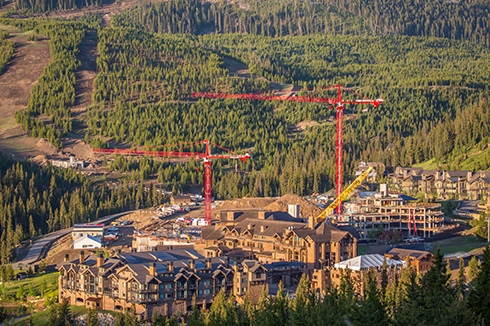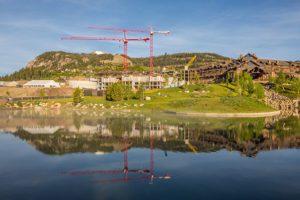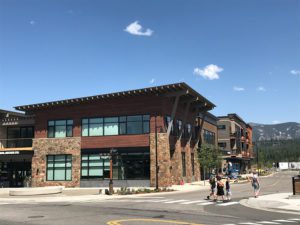Business
A billion dollar bet, part 3
Published
7 years agoon
Posted By
Outlaw Partners

Big Sky Resort, tucked among the wild peaks of southwest Montana, began with NBC News anchor Chet Huntley’s dream of “if you build it, they will come” in 1973 and is now attracting visitors and second homeowners in droves. Today, Big Sky epitomizes the modern Wild West as developers are betting big money, to the tune of $1 billion by some accounts, that it will be the world’s next great destination resort community, while its full-time residents hang on for the ride.
In this five-part series, Jackson, Wyoming-based writer Brigid Mander and Explore Big Sky staff interviewed nearly 100 sources to chart the development history of a community that sprouted at the base of a ski area—unusual for Western resorts that typically began as mining or railroad towns where ski infrastructure followed.
This series will take readers through the unorthodox development history of Big Sky, from Huntley’s big idea in the ‘70s; Boyne Resort’s purchase of the resort after Huntley’s untimely death; Tim Blixseth’s acquisition of large swaths of land around Big Sky Resort and his founding of the private Yellowstone Club; financial ruin of three large resorts during the Great Recession and CrossHarbor Capital Partners’ acquisition of them in bankruptcy court; and the explosive development, challenges and opportunities happening here today.
At the core of the community is an iconic, towering peak that’s been drawing snow speculators for more than four decades. – EBS Staff
Read part one here.
Read part two here.
Part 3: The Great Recession hits Big Sky hard, CrossHarbor buys in for pennies on the dollar
By Brigid Mander EBS Contributor
To the chagrin of modern-day conservationists and public land advocates, during the 19th century vast amounts of land were given as compensation to railroads in exchange for them building tracks to expand American industry and the economy.
President Abraham Lincoln in 1864 awarded land in what is now the Custer Gallatin National Forest to Northern Pacific Railroad, and over a century later the land was spun into a company called Plum Creek Timber. In the early 1990s, the Nature Conservancy—with $10 million pledged toward the purchase by conservationist and CNN founder Ted Turner—attempted to buy some of these sections in today’s Greater Yellowstone Ecosystem, considered ecologically important, for $25 million.
The deal fell through and in 1992 some of this land in southwest Montana caught the eye of a timber baron named Tim Blixseth whose company, Big Sky Lumber, acquired 139,000 acres for $24 million. Shortly thereafter, he turned around and offered to trade it to the U.S. Forest Service in exchange for consolidating land near Big Sky Resort.
The deal had opponents who didn’t want to see a huge swath of land near Big Sky, between two designated wilderness areas, become private. However, it would end private ownership of environmentally sensitive drainages along Yellowstone National Park’s boundary, and protect other nearby habitat also critical to wildlife.
Blixseth prevailed. His land swap required an act of Congress and President Bill Clinton to complete: by the end, two land swaps known as Gallatin I (1993) and Gallatin II (1998) saw the government trade 45,278 acres to Big Sky Lumber in exchange for 91,752 acres of public land to the U.S. Forest Service.
It was a catch-22 for conservation, notes Barb Cestero of the Wilderness Society’s Bozeman office. “I think it’s important we remember these land exchanges resulted in conservation gains and produced the current public access on the land that abuts Yellowstone and the southern Madison and Gallatin ranges,” she said. “I also don’t think in the ‘80s or ‘90s anyone anticipated the growth the area was going to experience.”
Of the 45,278 acres, Blixseth sold 25,000 acres to developers headed by Lee Poole, which became Moonlight Basin, and 6,678 acres to James Dolan, who created The Club at Spanish Peaks. Blixseth kept 13,600 acres for himself, and in doing so, Big Sky saw three new players enter the scene, each seemingly in charge of their own modern day fiefdom, with minimal governmental oversight.
“I was going to build a couple lifts, a house, and lock the gate [on the 13,600 acres],” Blixseth said. “But then a couple friends asked if they could join me and build houses too.” And so he came up with the idea of a private ski club, turning the parcel he’d kept into a place he called the Yellowstone Club.
As a private ski area, members would be required to buy real estate, pay yearly dues and a hefty $250,000 initial membership fee, which Blixseth says was required to run even a small operation with so few skier days. According to Blixseth, a Los Angeles-based consulting firm he hired told him that the idea wasn’t economically viable, and there wasn’t enough “wheel traffic” in the backwoods Montana outpost. “I fired them, and did it anyway,” he said.
The permit application with Madison County was to build 864 homes and 100 guest accommodations.
By 2004, Blixseth’s club was garnering fairly consistent national headlines such as “Millionaires Flocking to Yellowstone Club,” in the Los Angeles Times, and “Home, Home on the Million-Dollar Range,” in The New York Times in 2006.
Blixseth insists that, despite the sums of money needed to join and high-profile members such as Bill and Melinda Gates, he wanted to keep the club down to earth, like a family place to hang out. Stories floated around of club applicants jettisoned for treating employees poorly, or who were otherwise unpleasant to be around.
Partners in the Yellowstone Club included ski film producer Warren Miller—who is still listed on the club’s website as Honorary Director of Skiing—former NFL quarterback and congressman Jack Kemp, and pro golfer Annika Sorenstam. More recent members to join include Justin Timberlake and Jessica Biel, as well as Tom Brady and Gisele Bundchen.
Stephen Kircher, president of Boyne Resorts, says that while


The Yellowstone Club currently has 107 residences under construction, comprised of 28 personal member homes and 79 front doors being developed by the club, which includes 48 units in The Village. PHOTO BY DAVE PECUNIES
the increased media attention was good for business in the early days of the Yellowstone Club, Boyne now had to contend with uneasy new neighbors. At various points in time, each new neighbor battled over a contested 15-acre area near the summit of Lone Mountain.
“In 1998, I showed up, being responsible for Big Sky for Boyne, and my first meeting was Blixseth telling me he owned the top of Lone Mountain,” Kircher said. “He was in the middle of the Gallatin II land swap, and we negotiated a settlement for the land.”
It took a long time for Boyne to see the end of the deal—Blixseth didn’t turn it over, and during the next few years both Moonlight Basin and Spanish Peaks laid claim to the 15-acre spot. In 2013, the Montana Supreme Court legally awarded it to Boyne, after everyone else had gone bankrupt.
Kircher, who admits that Blixseth was a difficult neighbor, maintains respect for his accomplishments nonetheless. “Blixseth is a visionary, a complete out-of-the-box thinker. He brought this place to a level of prominence it would never have had otherwise. I mean, we’re ski operators from the Midwest,” Kircher said with a laugh. “His [Yellowstone Club] idea was sustainable, anyway, until he took that loan from Credit Suisse. He would have been okay, if he hadn’t gotten too big for his britches.”
Indeed, Blixseth went down in spectacular style from the rarefied kingdom he’d created at Yellowstone Club—even today, he admits he may have had an autocratic style, but he says he was “a benevolent dictator.”
In 2004, Credit Suisse approached him with a new syndicated loan product that allowed for loans of large, previously unavailable sizes. After declining the initial offer, according to documents from the United States Bankruptcy Court for the State of Montana, Blixseth agreed to a loan for $150 million, which later rose to $375 million, and was finalized in September 2005. The club was the asset that Blixseth borrowed against.
When Blixseth and his wife Edra agreed to an amicable divorce shortly thereafter, in early 2006, things went well until it came to the Montana property. No agreement could be reached, and Blixseth bitterly put the club up for sale. Sam Byrne, the managing partner of CrossHarbor and a very heavily invested Yellowstone Club member, offered $470 million for it. But Byrne backed out of the deal shortly before it was to close in early 2008, citing various problems.
Byrne had originally bought a lot for himself and one to develop in 2005, and the next year he bought a 58-unit condo development for $60 million. In 2007, he made another bulk purchase of lots for $54 million. A 2009 article by the Associated Press stated that Byrne had invested more than $200 million into the club.
Eventually, seeing no end, Blixseth gave the club to Edra, and she declared bankruptcy shortly afterward. Byrne’s CrossHarbor bought it out of a Montana bankruptcy court, and became the owner of the club in July 2009, with influential investors such as stakeholder and private equity billionaire Ron Burkle, and various minority stakeholders, for the bargain basement price of $115 million.
Blixseth tried to stop the deal until the end. Credit Suisse was ruled to have made an irresponsible loan, without conducting due diligence—similar loans to other resorts, like Idaho’s Tamarack, also resulted in financial ruin. Nonetheless, Credit Suisse filed lawsuits accusing CrossHarbor and Edra Blixseth of conspiring to bankrupt the club so it could be purchased on the cheap, but didn’t win its case.
The Yellowstone Club and its privacy-seeking homeowners were glad to move on from the media circus that the divorce and the case spawned. Numerous members were quoted in media outlets as happy to put it behind them and move forward under the calmer, un-sensational hand of CrossHarbor.
This wasn’t the end of financial collapses in Big Sky, however. The Dolan family’s Spanish Peaks filed for Chapter 7 bankruptcy in October 2011. In June 2013, CrossHarbor, in partnership with Boyne—Spanish Peaks owed Boyne more than $8 million, according to Kircher—bought it at auction for $26.1 million.
Moonlight Basin wasn’t far behind. Lehman Brothers, itself bankrupt, in 2008 foreclosed on Moonlight, which owed the lender approximately $170 million. In 2013, Lehman reached a deal to sell the resort development to Boyne and CrossHarbor for an undisclosed amount, in a “complicated Chapter 11,” said Matt Kidd, a managing partner at CrossHarbor.
“We believed in the market,” Kidd said. “After we bought the Yellowstone Club, we realized that Spanish Peaks and Moonlight Basin were more overleveraged than even Yellowstone, so we were able to wait, and move on them when we were ready.”
Leaving the Butte, Montana, courthouse after the Spanish Peaks auction in 2013, Dolan nodded in CrossHarbor’s direction. “[Byrne] is the new king of the valley,” Dolan said. “I wish him luck.”
Kidd says this is good news for Big Sky. “Fifteen years ago, this place was being developed by people who were in constant litigation, and hated each other. We’ve been trying to bring a cohesive vision and development here,” he said.


The new headquarters for CrossHarbor Capital Partners’ locally formed development subsidiary Lone Mountain Land Company, as well as its real estate sales under the banner of Big Sky Real Estate Co., will reside in the 25 Town Center Avenue building. Lone Mountain Land Company now owns approximately 5 acres in Big Sky Town Center and breaks ground July 21 on the Wilson Hotel. PHOTO BY TYLER ALLEN
CrossHarbor’s locally formed subsidiary, Lone Mountain Land Company, now owns approximately 5 acres of land in Big Sky Town Center. It has three commercial projects in the works, along with residential, retail and office space for related development.
Businesses began opening in LMLC’s 47 Town Center Avenue building this past winter and a grand opening will be held for the adjacent, 38,000-square-foot building at 25 Town Center Avenue on Friday, July 21. In addition to Lone Mountain Land Company and Big Sky Real Estate Co. headquarters, it will house a café and retail store.
There will also be a groundbreaking ceremony July 21 for the Wilson Hotel, a Marriot Residence Inn expected to open during the 2018-2019 ski season.
Reporting was contributed by EBS Managing Editor Tyler Allen.
Read the fourth installment in this series “Affordable housing, water and sewage, and traffic issues accompany explosive development” in the Aug. 4 edition of EBS.
The Outlaw Partners is a creative marketing, media and events company based in Big Sky, Montana.


Upcoming Events
april, 2024
Event Type :
All
All
Arts
Education
Music
Other
Sports
Event Details
Children turning 5 on or before 9/10/2024:
more
Event Details
Children turning 5 on or before
9/10/2024: Kindergarten
enrollment for the 2024-2025 school year can be completed by following the
registration process now.
Children
born on or after September 11, 2019: 4K enrollment is now open for
families that have a 4-year-old they would like to enroll in our program for
the 2023-2024 school year. Please complete the 4K Interest Form to
express your interest. Completing this form does not guarantee enrollment into
the 4K program. Enrollment is capped at twenty 4-year-olds currently
residing within Big Sky School District boundary full time and will be
determined by birth date in calendar order of those born on or after September
11, 2018. Interest form closes on May 30th.
Enrollment now is critical for fall preparations. Thank you!
Time
February 26 (Monday) - April 21 (Sunday)
Event Details
Saturday, March 23rd 6:00-8:00pm We will combine the heart-opening powers of cacao with the transcendental powers of breathwork and sound. Together, these practices will give us the opportunity for a deep
more
Event Details
Saturday, March 23rd 6:00-8:00pm
Time
March 23 (Saturday) 6:00 pm - April 23 (Tuesday) 8:00 pm
Location
Santosha Wellness Center
169 Snowy Mountain Circle
Event Details
We all are familiar with using a limited palette, but do you use one? Do you know how to use a
more
Event Details
We all are familiar with using a limited palette, but do you use one? Do you know how to use a limited palette to create different color combinations? Are you tired of carrying around 15-20 different tubes when you paint plein air? Have you ever wanted to create a certain “mood” in a painting but failed? Do you create a lot of mud? Do you struggle to achieve color harmony? All these problems are addressed in John’s workbook in clear and concise language!
Based on the bestselling “Limited Palatte, Unlimited Color” workbook written by John Pototschnik, the workshop is run by Maggie Shane and Annie McCoy, accomplished landscape (acrylic) and plein air (oil) artists,exhibitors at the Big Sky Artists’ Studio & Gallery and members of the Big Sky Artists Collective.
Each student will receive a copy of “Limited Palette, Unlimited Color” to keep and take home to continue your limited palette journey. We will show you how to use the color wheel and mix your own clean mixtures to successfully create a mood for your paintings.
Each day, we will create a different limited palette color chart and paint a version of a simple landscape using John’s directives. You will then be able to go home and paint more schemes using the book for guidance.
Workshop is open to painters (oil or acrylic) of any level although students must have some basic knowledge of the medium he or she uses. Students will be provided the book ($92 value), color wheel, value scale and canvas papers to complete the daily exercises.
Sundays, April 14, 21 and 28, 2024
Noon until 6PM.
$170.
Time
14 (Sunday) 12:00 pm - 28 (Sunday) 6:00 pm
Event Details
Come join us at Cowboy Coffee as we celebrate a fun night of drinks, games, and meeting others within the community. This event is from 6-8 and all are welcome
Event Details
Come join us at Cowboy Coffee as we celebrate a fun night of drinks, games, and meeting others within the community. This event is from 6-8 and all are welcome to come, if you don’t know who to bring come alone this is a great mixer event! This is an event hosted by Big Sky OUT as we work to provide queer safe spaces throughout the community.
Time
(Sunday) 6:00 pm - 8:00 pm
Location
Cowboy Coffee
25 Town Center Ave. Big Sky, MT 59716










